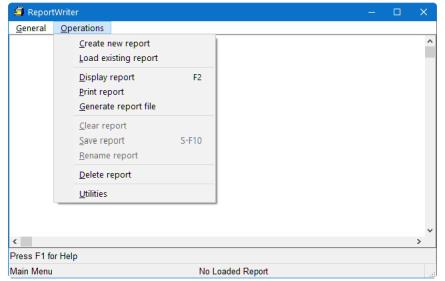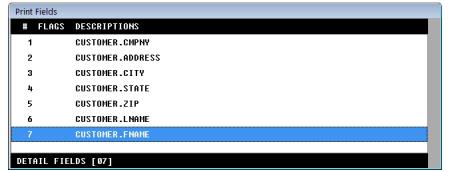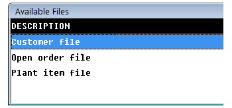The main menu, Operations, is displayed when you first start ReportWriter. (See figure 1.)
|
|
At the very bottom of the screen is the footer. It contains the name of the current menu or function, as well as the name of any report that is currently loaded.
Just above the footer is the information line. It contains information for the user, such as whether the Find entry function is operating in forward or reverse mode, and brief help information, when ReportWriter is processing input windows.
Making a menu selection (UNIX and OpenVMS)
You can select a menu entry using the arrow keys, quick-select characters, or shortcuts. To use the arrow keys or quick-select characters, you must first activate the menu bar by pressing the process-menu key, ctrl+p. The menu bar is deactivated after you select a menu entry. You can also deactivate it by pressing the process-menu key again.
- Arrow keys: Use the left and right arrow keys to move across the activated menu bar to select a menu. When you move to a menu, it drops down, displaying the entries. Use the up and down arrow keys to move among the menu entries. Press Enter to select a highlighted entry.
- Quick-select characters: A quick-select character is a single character that accesses a menu entry. When a menu is dropped down, type the quick-select character to highlight the menu entry and select it. If the quick-select character is not unique in the menu, it simply highlights the entry, and you will need to press Enter to select the highlighted entry.
- Shortcut keys: A shortcut is a key or key sequence that is associated with a menu entry, and which enables you to execute a function directly without selecting it from a menu. (The exception to this rule is arrow keys: arrow keys can be used as shortcuts only when the menu is not enabled.) The shortcut keys are listed to the right of the menu entry and vary depending on the type of terminal. Not all menu entries have shortcuts. See Appendix E: ReportWriter Distributed Shortcuts for a list of the most common shortcuts as they are provided with your original ReportWriter distribution. (Note that shortcuts can be reassigned by your system administrator.)
Entering data
The documentation refers to the Enter or Return key as Enter. After you have finished typing data for a particular field, press Enter to enter it.
|
|
Don’t forget to press Enter after you’ve typed data in the last field of an input window! If you exit the window without pressing Enter, the data you just typed in that field will be ignored (unless the field is a text field). |
ReportWriter converts most of the data you enter into uppercase letters. Descriptions or headings can be entered in mixed case.
Getting field-level help
For each input field, the information line displays a brief help message telling you what data to enter. For more detailed information, select General > Help to display a help window for the field. To close the help window, press Enter.
Accepting or overriding default values
In some ReportWriter fields, the program enters a default value for you. You can override the default by typing your own data, or you can accept the default by pressing Enter. For optional fields, you can override the default and leave the field blank by pressing the spacebar or the backspace key and then pressing Enter.
Moving between fields
On Windows, press the tab and shift+tab keys to move between fields in a window. You can also use the mouse to move directly to a specific field.
On UNIX and OpenVMS, you can use the Previous Field and Next Field entries on the Input menu to move between fields.
Skipping a field
To skip optional fields, simply press Enter. To remove a value from an optional field and leave it blank, press the spacebar or the backspace key and then press Enter.
Editing a field (UNIX and OpenVMS)
Changing the cursor direction
When you begin entering text in a field, the cursor direction is set to forward. To toggle between moving forward and backward, use the Direction option (on the Edit menu). This setting does not actually change the direction in which the cursor moves as you type; rather, it is honored by some of the options on the Edit menu. (Refer to the tables below for details on which options honor cursor direction.) The current direction is displayed on the right side of the information line.
Switching between insert and overstrike modes
When you begin entering text in a field, the editor is in insert mode. Any data you enter is placed at the current cursor position, and the existing data is moved to the right as you type. To change to overstrike mode, so that the data at the cursor is replaced with the data you type, use the Insert/Overstrike option (on the Edit menu). The current mode is displayed on the right side of the information line.
Editing a multi-line text field
When you start to type in a multi-line text field, the Edit menu appears on the menu bar. See the table below for an explanation of the available options on this menu.
To edit existing text in a multi-line field, use the right arrow key to move the cursor before you begin typing; the Edit menu will display on the menu bar, and then you can use the up and down arrow keys to move to the line you need to edit. (When you first access a multi-line text field that already has text in it, the entire field is selected. If you simply start typing, all existing text will be deleted. If this happens, you can abandon changes to recover the text.)
|
From the Edit menu, select… |
|
|---|---|
|
Move up one line |
Up One Line. The cursor stays in the same column position. |
|
Move down one line |
Down One Line. The cursor stays in the same column position. |
|
Move left one character |
Left One Character. |
|
Move right one character |
Right One Character. |
|
Move to the next word |
Move One Word. Cursor direction must be set to Forward. |
|
Move to first character of the current word |
Move One Word. Cursor direction must be set to Reverse. If the cursor is already on the first character of the word, it will move to the first character of the previous word. |
|
Move to the beginning of the line |
Beginning of Line. If the cursor is already positioned at the beginning of a line, it will move to the beginning of the previous line. |
|
Move to the end of the line |
End of Line. This moves the cursor past the last character in the current line. If the cursor is already positioned after the last character on the line, movement depends on the cursor direction setting.
|
|
Re-wrap text (join lines) |
Join Lines. This function rewraps the text from the cursor location to the end of the paragraph. |
Deleting the data in a field
You can erase the contents of the current field by selecting Input > Clear Field.
|
From the Edit menu select… |
|
|---|---|
|
The current character |
Delete Character. |
|
From the cursor to the beginning of the next word |
Delete Word. Cursor direction must be set to Forward. Note that this deletes all characters up to the beginning of the next word, including the current character and the space before the next word. |
|
From the cursor to the beginning of the current word |
Delete word. Cursor direction must be set to Reverse. All characters to the left of the cursor in the current word are deleted. |
|
From the cursor to the end of the line |
Delete to End of Line. The end-of-line character is not deleted. |
|
From the cursor to the end of the line (including the end-of-line character) |
Delete Line. Cursor direction must be set to Forward. If the next line contains text, that text moves up to the current line. |
|
From the cursor to the beginning of the line |
Delete Line. Cursor direction must be set to Reverse. Note that if the cursor is positioned on the first character of a line, this deletes the previous line of text, including the end-of-line character, and the remaining text moves up one line. |
To reset a field to its original value, select Input > Reset Field (UNIX and OpenVMS).
To abandon changes to all fields in a window, select General > Abandon. In a tabbed dialog, this abandons all changes to all tabs. On Windows, you can also click on the Cancel button to abandon changes for the current window or for all tabs in a tabbed dialog.
Using lists
ReportWriter uses two types of lists, modifiable and non-modifiable.
By default, lists display descriptions. To display entry names instead, select List > Toggle view. In a list of formats, Toggle view toggles between format strings and format names.
Modifiable lists
Modifiable lists, such as the Print Fields list in figure 2, contain entries that can be edited. You can add, delete, and possibly move entries in the list.
|
|
To edit an entry in a modifiable list, highlight it and press Enter or, on Windows, double-click.
To exit a modifiable list, press the Exit shortcut.
Non-modifiable lists
Non-modifiable lists contain entries that you can select, but cannot change, add, or delete. The Available Files list in figure 3 is a non-modifiable list.
|
|
To select an entry in a non-modifiable list, highlight it and press Enter or, on Windows, double-click.
To exit a non-modifiable list without making a selection, press the Exit shortcut.
Searching for a list entry
In both modifiable and non-modifiable lists, select Find > Find Entry to search for a list entry. At the prompt, enter the name or partial name of the entry you wish to find. If ReportWriter finds a match, it highlights the first matching entry in the list.
The default search direction is forward. To change the direction of the search, select Find > Toggle Direction. The search direction is displayed on the right side of the information line.
Making a selection from a selection window (UNIX and OpenVMS)
A selection window (sometimes referred to as a drop-down list) contains a list of items from which you can choose.
To select an item, press any key to display the list, use the arrow keys to highlight an item, and then press Enter. You can also type the first letter of the item to highlight it, and then press Enter.
To redisplay a selection window once you’ve made a selection, press any non-shortcut key at the prompt. If the key you press is the first letter of one of the selection window entries, that entry is highlighted when the selection window is displayed.
Exiting the current function
To save your changes and exit the current input window or list, select General > Exit. You are returned to the previous window or menu. Be sure to press Enter in the last field of the input window before exiting, so that the data in that field is entered.
On Windows, you can click the OK button to save your changes and exit the current input window.
Exiting ReportWriter
There are a couple of ways to exit ReportWriter.
- Press the Exit shortcut to back out of each function until no report is loaded and the Operations menu is displayed. Then, press the Exit shortcut again or select General > Quit.
- Select General > Quit to exit ReportWriter immediately from anywhere in the application.
If you try to exit ReportWriter without saving your work, you will be prompted to save the report.



